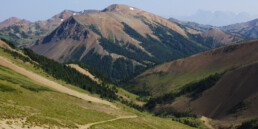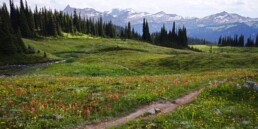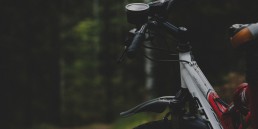Tips on Developing Mountain Biking Tourism
- Create excellent trail maps – maps that clearly show the best trails for mountain biking. Elevation profile maps and concise ride descriptions are also helpful, as are estimates of ride difficulty, descriptions of ride features, and seasonal (weather) and safety considerations. Maps can include pictures of trailheads and parking information. Map revenues can help fund trail and bicycling improvements.
- Identify and promote trails for cyclists of all abilities: Lightly traveled paved roads from towns and cities to trailheads; dirt roads and wide dirt paths that are easy to ride; twisting forest paths and narrow, challenging singletrack; plus downhill runs (if available). Being able to provide all of these experiences, in abundance, will help establish your area as a first-rate mountain biking destination. Adverise a whole system of trails, not just one.
- Recommended rides should pass by sites with historical interest and beautiful views.
- Consider offering hotel-to-hotel or hut-to-hut riding possibilities. Hut-to-hut rides have become popular in Colorado and elsewhere. Inn-to-inn (or hotel to hotel) rides are especially appealing to mountain bikers because they allow cyclists to ride light and free.
- Commission photographers to take photos of your riding area, which can be sent as slides or digital files to magazines and newspapers. These photos will serve as a tremendous magnet. Moab, Utah; Fruita, Colorado; and Slatyfork, West Virginia have built stellar images as a mountain bike destinations using just a few rolls of excellent mountain bike photos. IMBA can suggest photographers. These photos should also be used in widely distributed mountain bike tourism brochures and booklets.
- Offer FREE media mountain bike trips when you’re ready – not only to cycling magazine editors but to general magazine editors and even daily newspaper writers.
- Design, produce and post accurate trail signs to supplement the trail signs and markers that are already in place. No one likes sign pollution, but simple attractive markers that direct mountain bikers will be well received. This effort needs to be coordinated with other trail groups.
- Develop durable, sustainable trails. IMBA can help with trail maintenance and design advice.
- Offer other recreational activities and vacation elements that appeal to mountain bikers. Hiking, climbing, surfing and other tourism activities make an area attractive to visitors. Mountain bikers love to eat – and need to eat following a long day in the saddle – so abundant restaurant options are always appreciated. Mountain bikers will appreciate lists of restaurants that offer good food in a comfortable, casual atmosphere.
- Develop package deals that appeal to mountain bikers by combining lodging, meals and bicycle shop support.
- Build community support for bicycle tourism by emphasizing the economic benefits. Cyclists spend money on gas, food, lodging, souvenirs, etc. “If your commuity is not involved, you’re sunk. Visitors’ first stop is often the gas station, grocery store or welcome center. If the person there is not inviting to mountain biking, the next bicycling place may be just a short drive further.” — Troy Rarick, Fruita, CO
- Build the sport by facilitating the presence of quality retail bicycle shops. Shops can have a guest host who’s entire job is to talk about where to ride, camp, be responsible, etc.
- Singletrack is essential.
- Differentiate bicycling from motorcycling. Some people don’t understand the difference.
- Quantify everything – numbers before trails, numbers after trails, etc.
Sustainable Mountain Bike Tourism
By Troy Rarick, Over The Edge Sports, Fruita, CO
Without sustainability, you’re not doing a service to mountain biking and your community. I define unsustainable tourism as, “They come in, use something up, and go away.” With sustainable tourism, “They come in and ride a sweet singletrack and five years later people visit same singletrack and it remains in good condition.”
Camping is maybe the biggest problem of bicycle tourism. The Sand Flats Road in Moab is the access to the internationally famous Slickrock Trail. Early on in the 1980s, the US BLM left it alone and it gradually became a disaster, with people camping everywhere, causing damage to soils. That led to a fee program, where you have to pay to enter the area. All the proceeds are funneled back into the camping, the road and the trails. Nothing will ever manage itself. 80-90 percent of users are responsible, but there are 10-20% who will wreck the place.
You should educate visitors while they visit. Let them in on your local plans. In Fruita, we promote the motto, “Keep singletrack single.” My business depends on keeping trails narrow. We sell $2 trail maps and the money goes into a mountain bike patrol. We have a person in the store acting as a host Friday through Sunday. They’re trained to include in every conversation messages about low-impact camping. We’ll tell you where to camp but first tell you how.
We need an ethic permeating the mountain bike community so that wherever riders go, they already know what low impact use means, how not to wreck the place.



